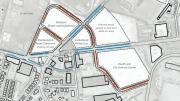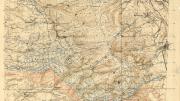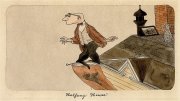Eleven months after the surprise announcement that much of the School of Engineering and Applied Sciences would move to new quarters in Allston, a task force of faculty members and administrators from the school, including dean Cherry Murray, has outlined parameters for the teaching and common spaces that might be purpose-built there. The SEAS facility is to rise as a newly designed structure at the site of the science complex where construction was halted in 2010 for financial reasons. The “White Paper on Teaching and Community Spaces in Allston” indicates tangible progress on moving toward design of the new building(s)—construction of which is a major priority for The Harvard Campaign. It also suggests how teaching, and the physical spaces in which teaching and learning take place, are evolving. Finally, it raises questions about possible overlap or conflict with other University capital projects now under way or being planned.
The Allston Spaces
The task force report begins with a series of stage-setting adjectives, meant to capture SEAS faculty members’ aspirations for their new campus: “Open. Connected. Active. Transparent. Livable. Sunlit. Social. Flexible.”
These emotionally resonant terms have substantive connections as well, the task force maintains:
We know that teaching methods are changing rapidly. Classrooms will no longer be places where teachers mainly transmit facts to students. Socially and technically skilled in the art of the Internet, students are voting their educational choices with their feet: not showing up for classes that expect them to sit still and take down what the lecturer is telling them, especially classes that are video-recorded. Technology has freed students from the need to use class time to get information. The faculty is in the process of liberating itself as well, re-inventing its pedagogy to use class time more productively.
Accordingly, the professors seek
spaces where the faculty can teach the students what the students cannot learn in other ways. Engineering skills, for example: to discover, design, create, and build things. To collaborate, to profit from continuous interaction and feedback and from discussion and shared insights. To oversee the supervised provocation that challenges conventional thinking. To interact with the materials and devices of the engineered world, to work with the hands and eyes as well as the mind, to experience the constructs and artifacts of applied science not just in the laboratories but everywhere in the engineering complex.
Even the idea of fixed classrooms, occupied from hour to hour by classes on various subjects, is now debatable. Perhaps, for many engineering subjects, the classroom should not be an all-purpose vessel, filled and emptied of interchangeable students and instructors several times a day. Projects are durable things. Racks of electronics are not mobile. Trays of gizmos will inevitably spill if they are moved from storage into and out of teaching spaces too many times. What would sensible engineers want? Space where stuff can be left in place when they break off their work, and be found where they left it when they return to the task. The hearts of some professors race as they imagine leaving student projects in place, blurring the edges between “preparation,” “class time” and “homework.”
Imagining an integrated campus where learning takes place not only inside classrooms, but everywhere, the task force recommends an integrated facility that is, as a pioneer of its kind on the Allston frontier, highly attractive to faculty members and students alike. To make that a reality, the report’s design principles:
Continue to support lecturing, and even large lectures, but discourage construction of “multiple, fixed-size, raked, poured-concrete amphitheaters that are neither reconfigurable day to day nor amenable to easy reconstruction when space demands change.” (Here and in other recommendations, in fact, the task force suggests that teaching and learning are in flux, and so it makes sense to build less expensively, to accommodate “relatively near-term renovations”—rather than to an institutional gold standard.)
Accommodate open atria or fora for open symposia and community meetings, with visual connections to other SEAS activities and passersby within the enterprise.
Advocate “consumer grade” communications and media technology. Embedded in that recommendation are both enthusiasm for technological enhancement of human teaching and a desire not to over-invest initially: “[I]t is better to under-design, under-invest, and cache enough money to do it over, than to try to design a costly, optimal, state of the art solution, which will have ceased to be the state of the art by the time the building opens.” The recent renovation of Stone Hall (part of Quincy House) and the design for the Dunster House renovation, unveiled in January, both incorporate a small, high-tech “smart classroom,” each with very advanced technology and communications. The SEAS task-force members clearly are familiar with and interested in such capabilities; they appear to be signaling a strong desire to deploy them at larger scale, but with a possible path toward more flexible, and more readily renewable, equipment.
Emphasize the importance of “project and instructional laboratory spaces” adjacent to classrooms—highlighting SEAS’s focus on experiential learning—a theme of broader pedagogical interest elsewhere in the University, but perhaps most advanced within engineering and applied sciences (see an experimental example here).
Make clear that the new complex is an engineering campus within a liberal arts university: “Through the use of open sight lines, transparent walls, and displays and exhibitions of Harvard’s current and historical technological inventions, the buildings should advertise the activities they foster.”
Other requirements, of course, include good transportation to the facility and inviting amenities: play and exercise spaces; showers for the physically active; and thoughtfully designed spaces for informal hanging out:
Students who want to hang out are often not looking for privacy, for example; while they want a little separation from others who are also hanging out (they generally don’t want long, quiet library tables), they may not want social isolation in secluded corners where they can neither see nor be seen by others. Think nooks, corners, benches, booths, cushions, soft seating (as long as it is lightweight—it will inevitably not want to sit still). Also important is proximity to food, drink, section meetings, and to the other Allston campus activities in which students will be engaged. And the open hours must be long, ideally 24x7; provision for appropriate security and transportation is one of many non-capital costs that must be built into the financial model for the Allston facility to make it succeed.
And, of course, “Food and drink. Like Napoleon’s army, the student body marches on its stomach.” All this, the task force hopes, will be built on a human scale, around an inviting quadrangle.
Where—and How—Teaching Takes Place
The recommendations for teaching spaces within the report suggest interesting changes in faculty visions for their work in the classroom. Not long ago, the “fixed-size, raked, poured-concrete amphitheater” was in fact the holy grail. During the review of the undergraduate curriculum that began a decade ago, a few Faculty of Arts and Sciences professors rose in faculty meetings to lament that teaching spaces had not made it on to the agenda, to mourn that they were confined to traditionally configured lecture halls, and to speak with envy of Harvard Business School’s HBS classic amphitheaters. Harvard Graduate School of Education’s recently renovated classrooms are very much in this mold.
But the SEAS faculty members are pointing in a very different direction. “Right now,” they write, “nothing is as big a constraint on pedagogical innovation in SEAS as the difficulty in finding flat-floor classrooms that can be fitted with lightweight tables and chairs” (which might be wheel-mounted and rapidly reconfigured for everything from a professor delivering a lecture to students working together in small teams).
And, lo and behold, HBS itself has built exactly this kind of teaching space in its new classrooms above the Harvard Innovation Lab: a new model for its team-oriented, non-case-based FIELD pedagogy for first-year students. Form very much follows, and enables, function. Faculty members in diverse schools are rapidly changing how they teach, with the University moving to build suitable spaces for doing so.
Too Many Communities of Harvard?
The amenities the task force seeks for the new Allston SEAS facility aim, as the white paper concludes, both to “[m]ake Allston a destination, a place students from across the College and the University will want to go and not to leave” (in part by making it possible to “get there easily and to stay late”) and to “[p]rovide enough resources for equipment safety, security, pedagogical renovation, food services, parking, and the like to keep the buildings happy and lively at all hours, even shortly after the new campus has been opened for business and the population size may be subcritical.”
As that last sentence suggests, part of this concern is transitional: SEAS will be in a new part of Harvard, for a while. But the recommendations—for food service, play spaces, and hanging-out facilities—are aimed in part at the permanent character of the place.
These plans are taking shape for Harvard growth in Allston even as the Faculty of Arts and Sciences is investing hundreds of millions of dollars in House renewal, aiming to make undergraduate residences more inviting in exactly the same ways: as reported, for instance, the new Dunster will have “new and expanded social and common spaces: a technologically equipped ‘smart’ classroom…aimed at bringing faculty members and teaching into the House; an art studio and music-practice space; a grille-common room complex; a game room; a student kitchen; a lounge connected to the courtyard; and a seminar room.”
At the same time, the new “common space” planned for the first floors of Holyoke Center, recently renamed the Smith Campus Center, may have similar amenities. A survey about possible uses for the center, recently circulated by its planning committee, outlines “informal and formal gathering spaces” and “spaces for relaxation, places for eating and gathering, study areas, performance and display facilities for the arts, and meeting spaces.” Survey respondents were asked about the appeal of space for activities ranging from “hanging out” and “art making (i.e., painting)” to “billiards, ping pong, karaoke,” “health and wellness activities” (from massage to yoga and cooking classes), and a variety of food options from formal dining to a pub.
How those uses will sort out, amid the competing commercial services already on offer in Harvard Square, is of course uncertain. How they are coordinated with the billion-plus dollars Harvard intends to invest in making the Houses more engaging for twenty-first-century undergraduates, and in making engineering and applied science an even more attractive intellectual hub for the University and a linchpin for Allston, is no small challenge for the Smith Campus Center Executive Committee.









